Alind Khare
Towards Efficient Large Multimodal Model Serving
Feb 02, 2025Abstract:Recent advances in generative AI have led to large multi-modal models (LMMs) capable of simultaneously processing inputs of various modalities such as text, images, video, and audio. While these models demonstrate impressive capabilities, efficiently serving them in production environments poses significant challenges due to their complex architectures and heterogeneous resource requirements. We present the first comprehensive systems analysis of two prominent LMM architectures, decoder-only and cross-attention, on six representative open-source models. We investigate their multi-stage inference pipelines and resource utilization patterns that lead to unique systems design implications. We also present an in-depth analysis of production LMM inference traces, uncovering unique workload characteristics, including variable, heavy-tailed request distributions, diverse modal combinations, and bursty traffic patterns. Our key findings reveal that different LMM inference stages exhibit highly heterogeneous performance characteristics and resource demands, while concurrent requests across modalities lead to significant performance interference. To address these challenges, we propose a decoupled serving architecture that enables independent resource allocation and adaptive scaling for each stage. We further propose optimizations such as stage colocation to maximize throughput and resource utilization while meeting the latency objectives.
DεpS: Delayed ε-Shrinking for Faster Once-For-All Training
Jul 08, 2024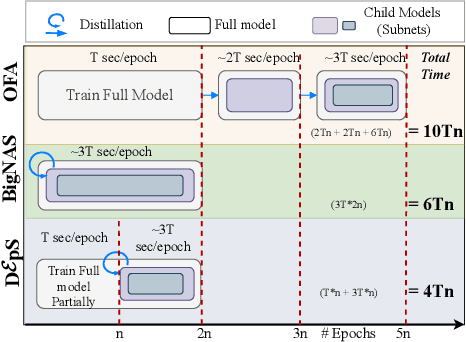



Abstract:CNNs are increasingly deployed across different hardware, dynamic environments, and low-power embedded devices. This has led to the design and training of CNN architectures with the goal of maximizing accuracy subject to such variable deployment constraints. As the number of deployment scenarios grows, there is a need to find scalable solutions to design and train specialized CNNs. Once-for-all training has emerged as a scalable approach that jointly co-trains many models (subnets) at once with a constant training cost and finds specialized CNNs later. The scalability is achieved by training the full model and simultaneously reducing it to smaller subnets that share model weights (weight-shared shrinking). However, existing once-for-all training approaches incur huge training costs reaching 1200 GPU hours. We argue this is because they either start the process of shrinking the full model too early or too late. Hence, we propose Delayed $\epsilon$-Shrinking (D$\epsilon$pS) that starts the process of shrinking the full model when it is partially trained (~50%) which leads to training cost improvement and better in-place knowledge distillation to smaller models. The proposed approach also consists of novel heuristics that dynamically adjust subnet learning rates incrementally (E), leading to improved weight-shared knowledge distillation from larger to smaller subnets as well. As a result, DEpS outperforms state-of-the-art once-for-all training techniques across different datasets including CIFAR10/100, ImageNet-100, and ImageNet-1k on accuracy and cost. It achieves 1.83% higher ImageNet-1k top1 accuracy or the same accuracy with 1.3x reduction in FLOPs and 2.5x drop in training cost (GPU*hrs)
SuperServe: Fine-Grained Inference Serving for Unpredictable Workloads
Dec 27, 2023
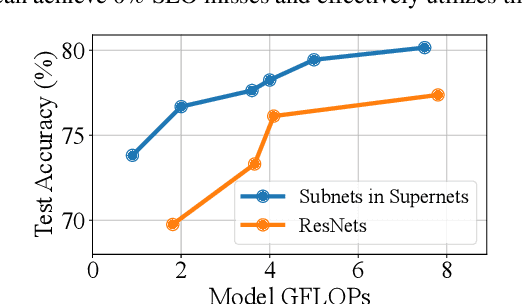
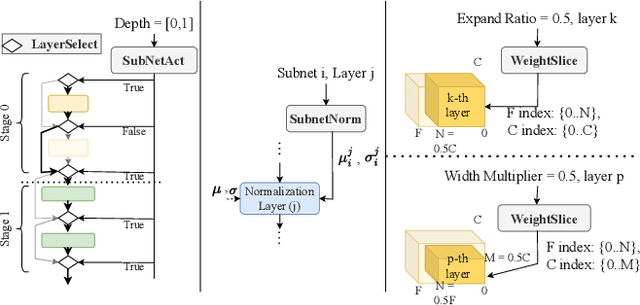

Abstract:The increasing deployment of ML models on the critical path of production applications in both datacenter and the edge requires ML inference serving systems to serve these models under unpredictable and bursty request arrival rates. Serving models under such conditions requires these systems to strike a careful balance between the latency and accuracy requirements of the application and the overall efficiency of utilization of scarce resources. State-of-the-art systems resolve this tension by either choosing a static point in the latency-accuracy tradeoff space to serve all requests or load specific models on the critical path of request serving. In this work, we instead resolve this tension by simultaneously serving the entire-range of models spanning the latency-accuracy tradeoff space. Our novel mechanism, SubNetAct, achieves this by carefully inserting specialized operators in weight-shared SuperNetworks. These operators enable SubNetAct to dynamically route requests through the network to meet a latency and accuracy target. SubNetAct requires upto 2.6x lower memory to serve a vastly-higher number of models than prior state-of-the-art. In addition, SubNetAct's near-instantaneous actuation of models unlocks the design space of fine-grained, reactive scheduling policies. We explore the design of one such extremely effective policy, SlackFit and instantiate both SubNetAct and SlackFit in a real system, SuperServe. SuperServe achieves 4.67% higher accuracy for the same SLO attainment and 2.85x higher SLO attainment for the same accuracy on a trace derived from the real-world Microsoft Azure Functions workload and yields the best trade-offs on a wide range of extremely-bursty synthetic traces automatically.
ABKD: Graph Neural Network Compression with Attention-Based Knowledge Distillation
Oct 24, 2023



Abstract:Graph Neural Networks (GNNs) have proven to be quite versatile for a variety of applications, including recommendation systems, fake news detection, drug discovery, and even computer vision. Due to the expanding size of graph-structured data, GNN models have also increased in complexity, leading to substantial latency issues. This is primarily attributed to the irregular structure of graph data and its access pattern into memory. The natural solution to reduce latency is to compress large GNNs into small GNNs. One way to do this is via knowledge distillation (KD). However, most KD approaches for GNNs only consider the outputs of the last layers and do not consider the outputs of the intermediate layers of the GNNs; these layers may contain important inductive biases indicated by the graph structure. To address this shortcoming, we propose a novel KD approach to GNN compression that we call Attention-Based Knowledge Distillation (ABKD). ABKD is a KD approach that uses attention to identify important intermediate teacher-student layer pairs and focuses on aligning their outputs. ABKD enables higher compression of GNNs with a smaller accuracy dropoff compared to existing KD approaches. On average, we achieve a 1.79% increase in accuracy with a 32.3x compression ratio on OGBN-Mag, a large graph dataset, compared to state-of-the-art approaches.
Subgraph Stationary Hardware-Software Inference Co-Design
Jun 21, 2023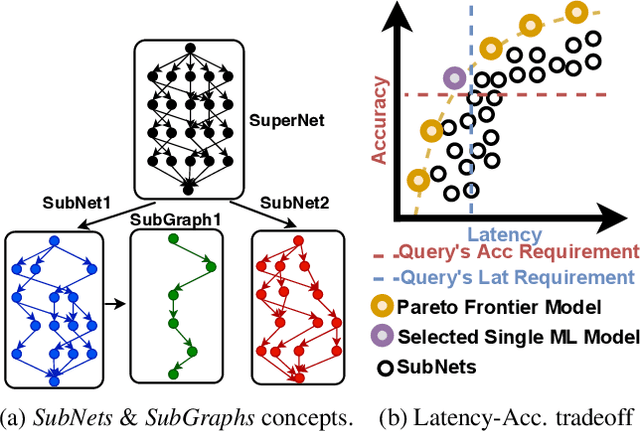



Abstract:A growing number of applications depend on Machine Learning (ML) functionality and benefits from both higher quality ML predictions and better timeliness (latency) at the same time. A growing body of research in computer architecture, ML, and systems software literature focuses on reaching better latency-accuracy tradeoffs for ML models. Efforts include compression, quantization, pruning, early-exit models, mixed DNN precision, as well as ML inference accelerator designs that minimize latency and energy, while preserving delivered accuracy. All of them, however, yield improvements for a single static point in the latency-accuracy tradeoff space. We make a case for applications that operate in dynamically changing deployment scenarios, where no single static point is optimal. We draw on a recently proposed weight-shared SuperNet mechanism to enable serving a stream of queries that uses (activates) different SubNets within this weight-shared construct. This creates an opportunity to exploit the inherent temporal locality with our proposed SubGraph Stationary (SGS) optimization. We take a hardware-software co-design approach with a real implementation of SGS in SushiAccel and the implementation of a software scheduler SushiSched controlling which SubNets to serve and what to cache in real-time. Combined, they are vertically integrated into SUSHI-an inference serving stack. For the stream of queries, SUSHI yields up to 25% improvement in latency, 0.98% increase in served accuracy. SUSHI can achieve up to 78.7% off-chip energy savings.
SuperFed: Weight Shared Federated Learning
Jan 26, 2023Abstract:Federated Learning (FL) is a well-established technique for privacy preserving distributed training. Much attention has been given to various aspects of FL training. A growing number of applications that consume FL-trained models, however, increasingly operate under dynamically and unpredictably variable conditions, rendering a single model insufficient. We argue for training a global family of models cost efficiently in a federated fashion. Training them independently for different tradeoff points incurs $O(k)$ cost for any k architectures of interest, however. Straightforward applications of FL techniques to recent weight-shared training approaches is either infeasible or prohibitively expensive. We propose SuperFed - an architectural framework that incurs $O(1)$ cost to co-train a large family of models in a federated fashion by leveraging weight-shared learning. We achieve an order of magnitude cost savings on both communication and computation by proposing two novel training mechanisms: (a) distribution of weight-shared models to federated clients, (b) central aggregation of arbitrarily overlapping weight-shared model parameters. The combination of these mechanisms is shown to reach an order of magnitude (9.43x) reduction in computation and communication cost for training a $5*10^{18}$-sized family of models, compared to independently training as few as $k = 9$ DNNs without any accuracy loss.
UnfoldML: Cost-Aware and Uncertainty-Based Dynamic 2D Prediction for Multi-Stage Classification
Oct 28, 2022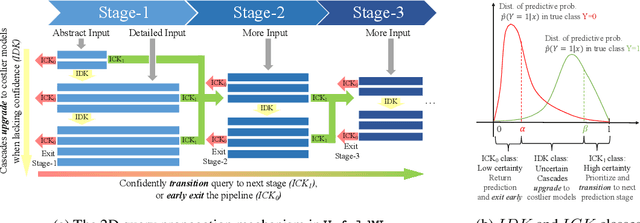

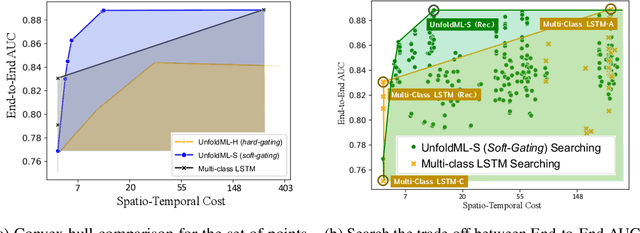

Abstract:Machine Learning (ML) research has focused on maximizing the accuracy of predictive tasks. ML models, however, are increasingly more complex, resource intensive, and costlier to deploy in resource-constrained environments. These issues are exacerbated for prediction tasks with sequential classification on progressively transitioned stages with ''happens-before'' relation between them.We argue that it is possible to ''unfold'' a monolithic single multi-class classifier, typically trained for all stages using all data, into a series of single-stage classifiers. Each single-stage classifier can be cascaded gradually from cheaper to more expensive binary classifiers that are trained using only the necessary data modalities or features required for that stage. UnfoldML is a cost-aware and uncertainty-based dynamic 2D prediction pipeline for multi-stage classification that enables (1) navigation of the accuracy/cost tradeoff space, (2) reducing the spatio-temporal cost of inference by orders of magnitude, and (3) early prediction on proceeding stages. UnfoldML achieves orders of magnitude better cost in clinical settings, while detecting multi-stage disease development in real time. It achieves within 0.1% accuracy from the highest-performing multi-class baseline, while saving close to 20X on spatio-temporal cost of inference and earlier (3.5hrs) disease onset prediction. We also show that UnfoldML generalizes to image classification, where it can predict different level of labels (from coarse to fine) given different level of abstractions of a image, saving close to 5X cost with as little as 0.4% accuracy reduction.
CompOFA: Compound Once-For-All Networks for Faster Multi-Platform Deployment
Apr 26, 2021



Abstract:The emergence of CNNs in mainstream deployment has necessitated methods to design and train efficient architectures tailored to maximize the accuracy under diverse hardware & latency constraints. To scale these resource-intensive tasks with an increasing number of deployment targets, Once-For-All (OFA) proposed an approach to jointly train several models at once with a constant training cost. However, this cost remains as high as 40-50 GPU days and also suffers from a combinatorial explosion of sub-optimal model configurations. We seek to reduce this search space -- and hence the training budget -- by constraining search to models close to the accuracy-latency Pareto frontier. We incorporate insights of compound relationships between model dimensions to build CompOFA, a design space smaller by several orders of magnitude. Through experiments on ImageNet, we demonstrate that even with simple heuristics we can achieve a 2x reduction in training time and 216x speedup in model search/extraction time compared to the state of the art, without loss of Pareto optimality! We also show that this smaller design space is dense enough to support equally accurate models for a similar diversity of hardware and latency targets, while also reducing the complexity of the training and subsequent extraction algorithms.
HOLMES: Health OnLine Model Ensemble Serving for Deep Learning Models in Intensive Care Units
Aug 10, 2020



Abstract:Deep learning models have achieved expert-level performance in healthcare with an exclusive focus on training accurate models. However, in many clinical environments such as intensive care unit (ICU), real-time model serving is equally if not more important than accuracy, because in ICU patient care is simultaneously more urgent and more expensive. Clinical decisions and their timeliness, therefore, directly affect both the patient outcome and the cost of care. To make timely decisions, we argue the underlying serving system must be latency-aware. To compound the challenge, health analytic applications often require a combination of models instead of a single model, to better specialize individual models for different targets, multi-modal data, different prediction windows, and potentially personalized predictions. To address these challenges, we propose HOLMES-an online model ensemble serving framework for healthcare applications. HOLMES dynamically identifies the best performing set of models to ensemble for highest accuracy, while also satisfying sub-second latency constraints on end-to-end prediction. We demonstrate that HOLMES is able to navigate the accuracy/latency tradeoff efficiently, compose the ensemble, and serve the model ensemble pipeline, scaling to simultaneously streaming data from 100 patients, each producing waveform data at 250~Hz. HOLMES outperforms the conventional offline batch-processed inference for the same clinical task in terms of accuracy and latency (by order of magnitude). HOLMES is tested on risk prediction task on pediatric cardio ICU data with above 95% prediction accuracy and sub-second latency on 64-bed simulation.
A Simple Dynamic Learning Rate Tuning Algorithm For Automated Training of DNNs
Oct 25, 2019
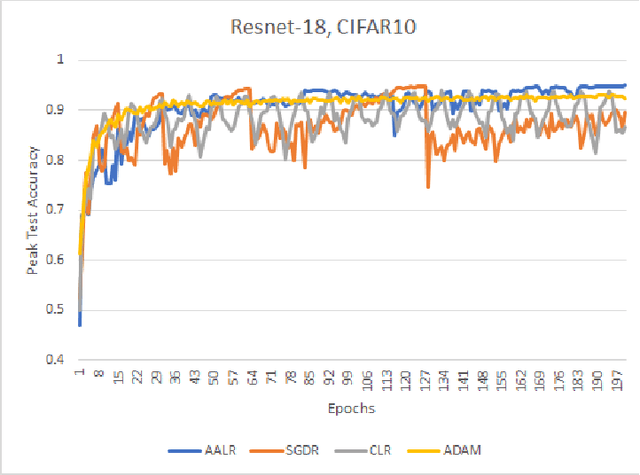

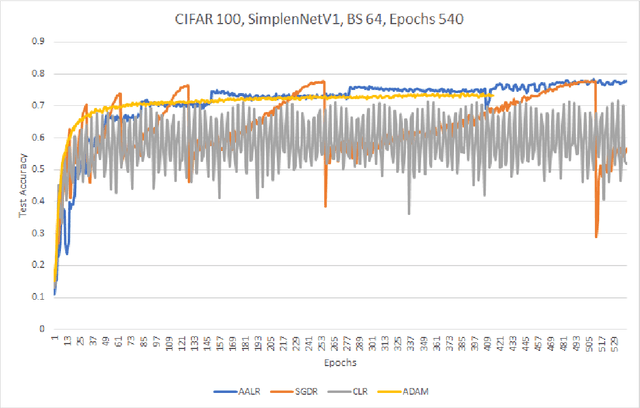
Abstract:Training neural networks on image datasets generally require extensive experimentation to find the optimal learning rate regime. Especially, for the cases of adversarial training or for training a newly synthesized model, one would not know the best learning rate regime beforehand. We propose an automated algorithm for determining the learning rate trajectory, that works across datasets and models for both natural and adversarial training, without requiring any dataset/model specific tuning. It is a stand-alone, parameterless, adaptive approach with no computational overhead. We theoretically discuss the algorithm's convergence behavior. We empirically validate our algorithm extensively. Our results show that our proposed approach \emph{consistently} achieves top-level accuracy compared to SOTA baselines in the literature in natural as well as adversarial training.
 Add to Chrome
Add to Chrome Add to Firefox
Add to Firefox Add to Edge
Add to Edge